Mushroom hunting
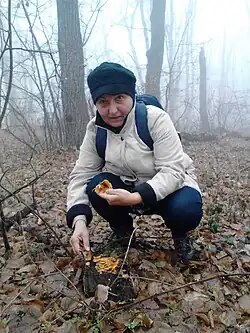
Mushroom hunting, mushrooming, mushroom picking, mushroom foraging, and similar terms describe the activity of gathering mushrooms in the wild. This is typically done for culinary purposes, although medicinal, psychotropic, and dyeing[1] uses are also known. Expert analysis is often required to distinguish between useful and poisonous species.
The practice is popular throughout most of Eurasia and Australia, as well as in West Africa,[2] and temperate regions of North America.
Identification
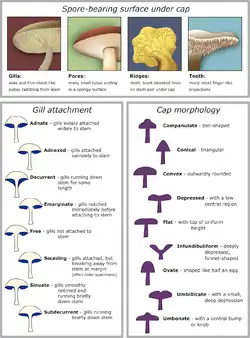
Numerous field guides on mushrooms are available to help distinguish between safe, edible mushrooms (or medicinal or psychotropic fungi) and the many poisonous or inedible species. Morphological characteristics of the caps, gills, and stems of mushrooms are often essential for correct visual mushroom identification. Microscopy is sometimes needed to eliminate lookalikes.[3]
A common identification technique is the spore print, in which a mushroom is placed on a surface and spores are allowed to fall underneath. This technique is often used by mycologists and mushroom hunters to identify the genus or species of a specimen and differentiate between similar-looking taxa.[4]
Mushrooms generally begin to fruit when it is both warm and moist in their region.[5] In the North American Pacific Northwest, species shortly occur from spring to summer, but are most common in autumn. In the Southwestern United States, mushrooms can be found during the winter rains and spring. In the Midwest and Northeast U.S., they can be found from late April until the frosts of autumn. In the Colorado Rockies, they are best collected in July and August. They can be found through winter on the Gulf Coast.[5]

Commonly collected species
Many species of mushrooms are highly prized. Chanterelles, for example, are popular in both Europe and the United States. On the West Coast of the United States, they are harvested commercially.[6] Hedgehog mushrooms are also popular, and get their name from the spines on the underside of the cap.[7] Morels are another popular edible mushroom, and are extremely popular.[8] Lobster mushrooms are edible as well, and have a shellfish-like flavor. They also have no look-alikes.[9] The porcini is also edible and very highly regarded. It is very popular in Italy, and prized for its nutty flavor.[10]
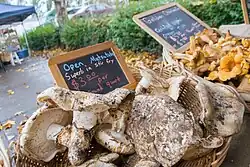
The Caesar's mushroom is another edible mushroom. However, it is in the Amanita genus, and therefore one must be very careful when identifying it.[11] It gets its name because it was popular among Roman emperors.[12] The matsutake, another edible mushroom, is popular in Japan. It also occurs in the Pacific Northwest.[13] There are actually multiple species of matsutakes, and the Japanese species does not occur in North America.[14] The matsutake has a spicy aroma, which David Arora has likened to "Red Hots and dirty socks".[15] Care must be taken to not confuse the matsutake with the extremely poisonous Smith's amanita.[16]
Little brown mushrooms
The term little brown mushroom (LBM) refers to any of a large number of small, dull-coloured agaric species, with few uniquely distinguishing macromorphological characteristics.[17] As a result, LBMs typically range from difficult to impossible for mushroom hunters to identify. Experienced mushroom hunters may discern more subtle identifying traits that help narrow the mushroom down to a particular genus or group of species, but exact identification of LBMs often requires close examination of microscopic characteristics plus a certain degree of familiarity or specialization in that particular group.[18]
Additionally, boring ubiquitous mushroom (BUM) describes groups of difficult to identify larger agarics, many of which are in the genus Hebeloma.[19][20] Just another Russula (JAR) can refer to any species of Russula that is common or difficult to identify.[21][22] Yet another Mycena (YAM) describes any of the many Mycena species that are common, nondescript, or difficult to identify.[23]
-
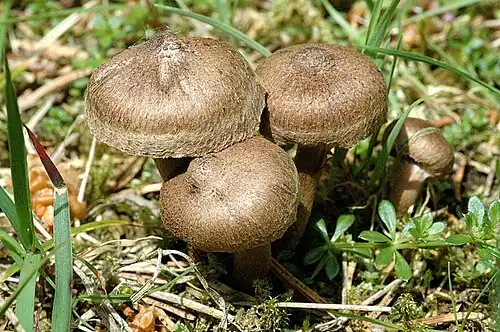 Inocybe lacera, a typical LBM best identified via microscopy
Inocybe lacera, a typical LBM best identified via microscopy -
_Qu%C3%A9l_272561_crop.jpg) The difficult-to-distinguish Hebeloma crustuliniforme
The difficult-to-distinguish Hebeloma crustuliniforme -
 Galerina marginata is another LBM, and is extremely toxic.
Galerina marginata is another LBM, and is extremely toxic.
Location
Particular mushrooms are associated with certain conditions such as proximity to certain types of trees and habitat.[24][25] Mycologist David Arora provides an exhaustive list.[26]
By tree
By habitat
Collection
Although some individual species do not preserve well, many do with proper care. David Arora recommends the use of a firm container such as a basket, with lighter specimens stored above heavier ones and species being separated using waxed paper (not plastic bags, which trap moisture and cause rot); as the negative gravitropism of fungi tends to orient the gills downward, taller mushrooms must be stored upright.[27]
Poisonous mushrooms
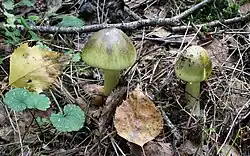
Mushroom hunting can be dangerous if one is not careful due to the fact that certain edible and poisonous species look alike. While some poisonous mushrooms simply cause digestive upset, others can cause organ failure or even death.[28] Certain species in the genus Amanita, such as the death cap (A. phalloides) and destroying angel (A. ocreata), are the cause of most fatal mushroom poisonings.[1] The deadly Amanita species contain amatoxins, which can cause kidney failure. Death caps can be mistaken for edible paddy straw mushrooms.[29] However, paddy straw mushrooms do not occur in the United States, and are instead found in Asia.[30] When young, death caps can also be confused with edible puffball mushrooms due to their similar shape. However, they can be differentiated if cut open. While a puffball is solid white inside, a young death cap has a mushroom shape visible.[29] Amanita bisporagera, another amatoxin-containing Amanita species, also known as destroying angel, can be mistaken for edible meadow mushrooms.[31] Galerina marginata and Pholiotina rugosa also contain amatoxins.[32] While Galerina marginata is rarely eaten[32] because it is so small,[1] it can sometimes be confused with hallucinogenic Psilocybe species.[32] Cortinarius rubellus and Cortinarius orellanus contain a deadly toxin called orellanine, which can destroy the liver and kidneys.[33] The jack o' lantern mushroom (Omphalatus olearius), which causes gastrointestinal distress, can sometimes be confused with edible chanterelle mushrooms.[34]
Some poisonous species, such as Amanita muscaria,[35] Paxillus involutus,[36] and Gyromitra esculenta,[37] are eaten in some places if parboiled in a certain way. However, Paxillus involutus has some toxins which cannot be removed by cooking, and accumulate in the body over time and can kill the person who ate the mushroom later on.[36] While Gyromitra esculenta is eaten, parboiling doesn't always remove the toxins, and consumption of this mushroom is also not recommended.[37]
Regional importance
Mushroom hunting is popular throughout most of Europe, Asia and Australia, as well as in temperate regions of Canada and the U.S.[38][39][40][41]
- British enthusiasts enjoy an extended average picking season of 75 days compared to just 33 in the 1950s.[42]
- In Japan, particular mushroom types are hunted, with particular importance given to delicacies such as the Matsutake mushroom.
- In Slavic countries and Baltic countries, mushroom picking is a common family activity.[43] According to David Arora, "The Russians go absolutely bananas for fungus. Mushrooming is a commonplace tradition there, not the hallowed turf of the academic or connoisseur."[44] After a heavy rain during the mushroom season whole families often venture into the nearest forest, picking bucketfuls of mushrooms, which are cooked and eaten for dinner upon return (most often in omelettes with eggs or fried in butter) or alternatively dried or marinated for later consumption. In Southern Lithuania mushroom hunting is considered a "national sport". They even host a Mushroom Festival ("Grybų šventė") in Varėna including a mushroom hunting championship.
- In the U.S., mushroom picking is popular in the Appalachian area and on the west coast from San Francisco Bay northward, in northern California, Oregon and Washington, and in many other regions.
- In Nigeria, the sclerotia of Pleurotus tuber-regium are reportedly added to soups and used medicinally to treat mumps.[2]
- In Cameroon, Flamulina velutipes is considered a delicacy, and gathered by women and children in rural areas.[45]
-
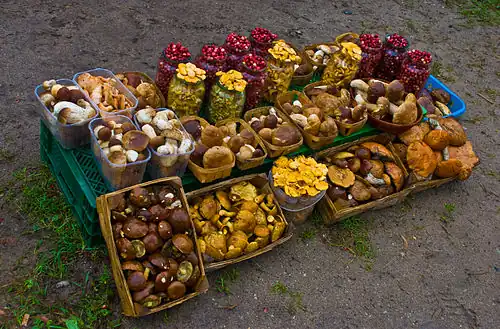 Mushrooms and berries collected in Lithuania
Mushrooms and berries collected in Lithuania -
Forest-picked mushrooms at a Ukrainian market in Kolomyia
-
 A basket of edible mushrooms from Ukraine
A basket of edible mushrooms from Ukraine
Festivals
The popularity of mushroom picking in some parts of the world has led to mushroom festivals. The festivals are usually between September and October, depending on the mushrooms available in a particular region. Festivals in the United States include:
- Boyne City, Michigan – Annual National Morel Mushroom Festival[46]
- Mount Pisgah, Oregon – Mushroom Festival[47]
- Madisonville, Texas – Texas Mushroom Festival[48]
- Telluride, Colorado – Telluride Mushroom Festival[49]
Radiation
Nuclear fallout from the Chernobyl disaster is an important issue concerning mushroom picking in Europe. Due to the wide spread of their mycelium, mushrooms tend to accumulate more radioactive caesium-137 than surrounding soil and other organisms. State agencies (e.g. Bellesrad in Belarus) monitor and analyze the degree of radionuclide accumulation in various wild species of plants and animals. In particular, Bellesrad claims that Svinushka (Paxillus ssp.), Maslenok (Suillus ssp.), Mohovik (Xerocomus ssp.), and Horkushka (Lactarius rufus) are the worst ones in this respect. The safest one is Opyonok Osyenniy (Armillaria mellea). This is an issue not only in Poland, Belarus, Ukraine and Russia: the fallout also reached western Europe, and until recently the German government discouraged people gathering certain mushrooms.
See also
References
- ^ a b c Arora, David (February 1, 1991). All that the Rain Promises and More: A Hip Pocket Guide to Western Mushrooms. Berkeley: Ten Speed Press. ISBN 9780898153880.
- ^ a b "(PDF) Ethnomycological Conspectus of West African Mushrooms: An Awareness Document". ResearchGate. Archived from the original on 2024-11-12. Retrieved 2025-08-19.
- ^ Arora 1986, p. 58.
- ^ Arora 1986, pp. 18–19.
- ^ a b Audubon (2023). Mushrooms of North America. Knopf. p. 13. ISBN 978-0-593-31998-7.
- ^ Arora 1986, p. 663.
- ^ "The Hunt for Hedgehogs". mssf.org. Retrieved 2025-08-19.
- ^ "Morels". Missouri Department of Conservation. Retrieved 2025-08-19.
- ^ Bergo, Alan (2013-01-15). "Lobster Mushrooms". Forager | Chef. Retrieved 2025-08-19.
- ^ "Porcini Mushrooms: Facts and Gourmet Uses - Mushroom Appreciation". www.mushroom-appreciation.com. 2022-02-24. Retrieved 2025-08-19.
- ^ "Amanita Caesarea: The Edible Caesar's Mushroom - Mushroom Appreciation". www.mushroom-appreciation.com. 2022-02-27. Retrieved 2025-08-19.
- ^ "Amanita caesarea, Caerer's mushroom, Tom Volk's Fungus of the Month for March 2002". botit.botany.wisc.edu. Retrieved 2025-08-19.
- ^ "Wild About Mushrooms: Matsutake". www.mssf.org. Retrieved 2025-08-19.
- ^ "American Matsutake: Identification, Foraging, and Concerns - Mushroom Appreciation". www.mushroom-appreciation.com. 2022-08-30. Retrieved 2025-08-19.
- ^ Arora 1986, p. 191.
- ^ "Amanita smithiana – Mushrooms Up! Edible and Poisonous Species of Coastal BC and the Pacific Northwest". explore.beatymuseum.ubc.ca. Retrieved 2025-08-19.
- ^ Læssøe, H.; Petersen, Jens (2019). Fungi of Temperate Europe. Princeton University Press. p. 616. ISBN 9780691180373.
- ^ Arora 1986, pp. 32–33.
- ^ Arora 1986, p. 463.
- ^ Chang, T. Susan (May 24, 2006). "Morel Satisfaction: Stalking the Wild Mushroom". NPR. p. 1.
- ^ "Russula". Colorado Mushrooms. Retrieved 2023-08-28.
- ^ Arora 1986, p. 84.
- ^ Arora 1986, p. 235.
- ^ "Here's What You'll Need to Start Foraging Mushrooms". Wirecutter: Reviews for the Real World. 2020-07-13. Retrieved 2023-08-30.
- ^ Oliver (2022-07-15). "Beginner's Guide to Mushroom Foraging & Hunting 101". Curative Mushrooms. Retrieved 2023-08-30.
- ^ Arora 1986, pp. 35–47.
- ^ Arora 1986, p. 12.
- ^ Arora 1986, pp. 892–896.
- ^ a b "Amanita phalloides – Mushrooms Up! Edible and Poisonous Species of Coastal BC and the Pacific Northwest". explore.beatymuseum.ubc.ca. Retrieved 2025-08-19.
- ^ "Fungi: Poisonous Mushroom Look Alikes | Fungi". mushroomexam.com. Retrieved 2025-08-19.
- ^ "Destroying Angel | Missouri Department of Conservation".
- ^ a b c Veiss, Debbie (August 14, 2022). "Amatoxin: The Deadliest of All Mushroom Poisonings".
- ^ "Cortinarius rubellus, Deadly Webcap mushroom". www.first-nature.com. Retrieved 2025-08-19.
- ^ "Toxic mushrooms". gencat.cat. Retrieved 2025-08-19.
- ^ Rubel, William (2011-09-30). "Amanita muscaria, edibile if parboiled". William Rubel. Retrieved 2025-08-19.
- ^ a b "Brown Rollrim". Wild Food UK. 2017-06-27. Retrieved 2025-08-19.
- ^ a b "The Big, Bad, Beefy False Morel: Complete Guide to Identification and Edibility - Mushroom Appreciation". www.mushroom-appreciation.com. 2024-02-19. Retrieved 2025-08-19.
- ^ "Mushroom Hunting Gains Popularity in US". VOA. 2018-11-19. Retrieved 2023-08-30.
- ^ "Love mushrooms? California is having an epic 'supershroom' season". Environment. 2023-02-15. Archived from the original on February 15, 2023. Retrieved 2023-08-30.
- ^ "Colorado mushroom hunting: What you need to know before you start foraging". The Denver Post. 2020-05-18. Retrieved 2023-08-30.
- ^ Malone, Trey; Swinton, Scott M.; Pudasainee, Aastha; Bonito, Gregory (2022-03-01). "Economic Assessment of Morel (Morchella spp.) Foraging in Michigan, USA". Economic Botany. 76 (1): 1–15. doi:10.1007/s12231-022-09548-5. ISSN 1874-9364. PMC 9012437. PMID 35465299.
- ^ Gange, A. C.; Gange, E. G.; Sparks, T. H.; Boddy, L. (2007). "Rapid and recent changes in fungal fruiting patterns". Science. 317 (5821): 71. Bibcode:2007Sci...316...71G. doi:10.1126/science.1137489. PMID 17412949. S2CID 11405866.
- ^ Seifner, Patricia (4 September 2019). "Brace yourselves! It's Mushroom Hunting Season in Russia!". Liden & Denz.
- ^ Arora 1986, p. 3.
- ^ Yongabi, Kenneth (2004). "Ethnomycological Studies on wild mushroom in Cameroon, Central Africa". Micología Aplicada Internacional: 34–36.
- ^ "MOREL MUSHROOM FESTIVAL". MOREL MUSHROOM FESTIVAL. Retrieved 2025-08-19.
- ^ "Mushroom Festival". Mount Pisgah Arboretum. Retrieved 2025-08-19.
- ^ "Texas Mushroom Festival". txmushfest.org. Archived from the original on 2025-04-26. Retrieved 2025-08-19.
- ^ "Telluride Mushroom Festival". Visit Telluride. Retrieved 2025-08-19.
Sources
- Arora, David (1986) [1979]. Mushrooms Demystified: A Comprehensive Guide to the Fleshy Fungi (2nd ed.). Berkeley, CA: Ten Speed Press. ISBN 978-0-89815-170-1.
Further reading
- 100 Edible Mushrooms: With Tested Recipes(2007) ISBN 0-472-03126-0
- All That the Rain Promises, and More (1991) ISBN 0-89815-388-3
- Edible and Medicinal Mushrooms of New England and Eastern Canada (2009) ISBN 978-1-55643-795-3 (1-55643-795-1)
- Edible Wild Mushrooms of North America: A Field-to-kitchen Guide (1992) ISBN 978-0-292-72080-0
- How to Identify Edible Mushrooms (2007) ISBN 0-00-725961-1
- Mushrooming Without Fear (2007) ISBN 1-60239-160-2
- Mushrooms Demystified: A Comprehensive Guide to the Fleshy Fungi (1986) ISBN 0-89815-169-4
- Mushrooms of Northeastern North America (1997) ISBN 0-8156-0388-6
- North American Mushrooms: A Field Guide to Edible and Inedible Fungi (2006) ISBN 0-7627-3109-5
- The Mushroom Rainbow: Only the most delicious or deadly mushrooms sorted by color (2011) ISBN 978-0-9869409-0-3 (0986940909)